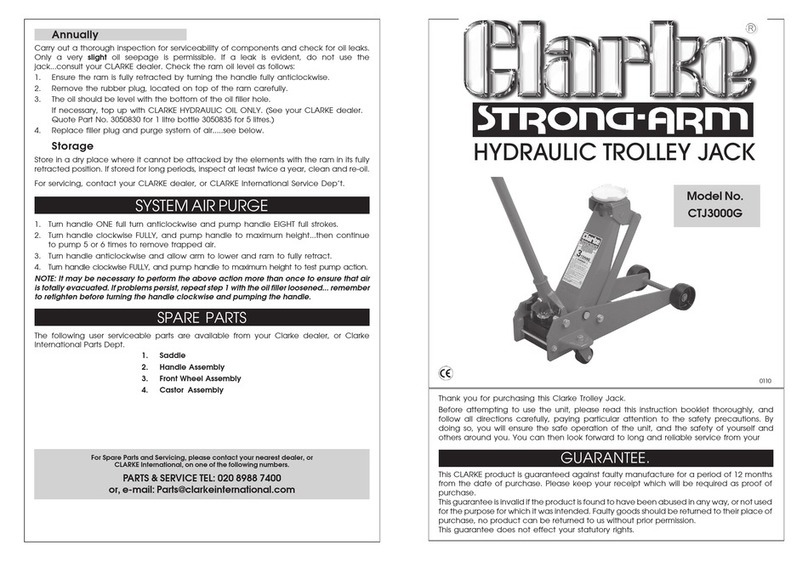
1 FORWARD
This manual was created by greenworks®. It is the
responsibility of the operator to be knowledgeable of
and comply with workplace rules and the environmental
conditions of use.
1.1 PURPOSE
This product may be used to raise vehicles, mowers,
trailers, etc, far enough so the machine can be
supported with appropriate jack stands. This manual,
however, is written for the intended use of raising up a
vehicle for further support by an appropriate jack stand
only. Please refer to the owner's manual of the machine
being lifted for the total vehicle weight and proper lifting
location. The maximum loading weight on this product is
6613 lbs (3000 kg).
2 IMPORTANT SAFETY
INSTRUCTIONS
DANGER
DANGER indicates a hazardous situation which, if not
avoided, may result in death or serious injury.
WARNING
WARNING indicates a hazardous situation which, if
not avoided, could result in death or serious injury.
CAUTION
CAUTION indicates a hazardous situation which, if not
avoided, could result in minor or moderate injury.
Note is used to address practices not related to
personal injury. Notice signs are typically used for
activities that result in property damage.
WARNING
Please refer to the vehicle owner’s manual for
proper placement of the jack.
Read and understand all safety warnings,
instructions, illustrations, and specifications
provided with and/or on this jack.
Failure to follow all instructions listed in this
manual will create a hazardous environment
which, if not avoided, could result in death or
serious injury.
Note: Save all warning and instructions for future
reference. Do not remove any safety labels that are
affixed on this product.
2.1 SAFETY WARNINGS
WARNING
Even when all safety requirements are observed,
some risk may still exist. Make sure the area under
the car is clear when it is raised or lowered to
avoid injury. Never get under a vehicle that is only
supported by a jack. The use of appropriate jack
stands is required during use at all times.
• The operator must work in accordance with the
vehicle and product user manual.
• Only use the handle to carry the product. Do not use
the piston to carry the product.
• Any rebuilding or modification of the jack will void
the warranty.
• Do not use the product when tired, fatigued, and or
under the influence of drugs or alcohol.
• When the product is not in use, turn the product off
and remove the power source.
• Do not use the product if it has been exposed to
water.
• Refer to the vehicle owner's manual to find the
vehicle weight. Do not use if the vehicle is over the
product’s load limit.
• The product should only be operated by a person
that has fully read and understands the information
in this manual and complies with all safety warnings
and instructions.
• The product uses hydraulic oil and must be kept in a
well-ventilated area. Only use the product within the
following temperature range of 32˚F – 113˚F (0˚C –
45˚C).
• At the end of the product’s lifespan, do not dispose
of it in household waste. The oil and other materials
may pollute the environment. Dispose of the product
according to local and federal regulations.
• Do not use the jack if the ground incline exceeds 5°.
• Do not use the jack if it is incorrectly positioned,
if the load of the vehicle is not supported properly,
and/or if the load of the vehicle exceeds the stated
jack limit.
• Do not service the jack unless the power is turned
off and disconnected from the battery.
• Visual inspection shall be made before each use
of product by checking for abnormal conditions,
e.g., cracked welds, leaks, and damaged, loose, or
missing parts.
• Other inspections shall be made per product
operating instructions.
• Any product that appears to be damaged in any
way, is found to be worn, or operates abnormally
SHALL BE REMOVED FROM SERVICE UNTIL
REPAIRED. Necessary repairs should be made by a
manufacturer’s or supplier’s authorized repair facility
4
English (Original Instructions)
EN



























